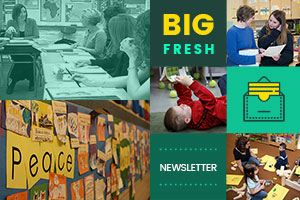AI will not replace humans, but those who use AI Will replace those who don’t.
—Ginni Rometty, Former CEO of IBM
Four Things I Didn’t Use AI for This Week (But Could Have)
When I reflect on this school year, I realize that one of the biggest changes has been my use of AI. Each day I’m discovering new uses and valuable ways it is changing how I work. Inspired by Dana Murphy’s article, “Five Things I Used AI for This Week,” I decided to make a list of Four Things I Didn’t Use AI for This Week.
Revision on Chapter 2
Becca Burk and I spent copious hours in May working to meet the deadline for the book we’re writing together. Chapter 2 consumed 22+ hours, and we thought it might be the doom of the whole book. One of the issues was the length of some of the anecdotes. It would have been so easy to drop them into ChatGPT and ask for concise, short versions. I resisted. I want to be able to say that we wrote the book, not an AI bot. Not only that, but in working through the revisions, we realized that the problem wasn’t the length of the anecdotes, but the structure of the chapter. Doing the gritty work allowed us to clarify our ideas, not just for readers, but for ourselves too.
Recipe Suggestions
A friend shared with me that she loves to put a list of ingredients into ChatGPT and then ask for recipe suggestions. I thought this might be fun, but then I decided to resist. The early reports about AI being an energy hog gives me pause. Do I really need to be using so much energy for a recipe search when I could use Google instead…or better yet, my old-fashioned recipe box? Because I put down my phone and started chopping the ingredients, my husband and I created a new dish. It was satisfying because of the time together, the taste, and the break from technology.
A Difficult Email
Recently a school administrator shared with me that for a professional learning session, he told teachers they can write a nasty email in AI as a means to vent, and then with a short prompt and a click of a button, have it rewritten in a professional tone. “Go ahead and be mean-spirited. AI will smooth it out for you,” he advised. I decided my energy was better spent in going for a swim to give space between a difficult situation and writing the follow-up email I needed to write. After my mind was clear, I was able to write an authentic and professional email, reminding myself of Brené Brown’s words: Clear is kind.
A Gift Suggestion
Our youngest son recently left for a two-month training several states away. I wanted to give him a meaningful gift to encourage him before he left. I was tempted to ask AI. I even started putting in the parameters for the prompt, but a few sentences in, I realized this was something I wanted to happen more organically. I wanted to take the time to think about Sam, to reflect on his journey, and to decide for myself the message I wanted to give him. I don’t need a machine offering suggestions for a heartfelt gift for my son. (Now, suggestions for a baby shower gift for a colleague was a different story.)
I’m finding myself being just as intentional about what I don’t use AI for as what I do. Just so you know, my lead essays are always generated by me…not by a bot. This week we look at the way generative AI is influencing the way we do our work—plus more, as always.
Shine on,
Ruth Ayres
Editor in chief

Inspired by a third-grade teacher, Suzy Kaback uses AI to generate an imaginary student to engage her teacher candidates as they mediate teaching and learning through a proxy.
Troy Hicks weighs in on AI and writing instruction.
Marielle Segarra and Shannon Bond discusses AI-generated images and how to spot them in this episode of the Life Kit podcast.
Consider attending the NCTE-NCTM Joint Conference in Chicago on June 16—18. I’ll be presenting with other Choice Literacy/Numeracy contributors: Jodie Bailey, Becca Burk, Mallory Messenger, and Mandy Robek. We’d love to connect with you!

New members-only content is added each week to the Choice Literacy website. If you’re not yet a member, click here to explore membership options.
From lesson planning to generating decodable texts, Dana Murphy shares five ways she uses AI as a reading interventionist.
David Pittman offers practical and time-saving tips for using AI to help make instructional plans. Need a rubric or discussion questions? David shows how using AI offers a springboard for creating tools for elementary literacy instruction.
Julie Cox wrestles with the use of AI to support high school writers. In this article she offers filters for educators to determine the role of AI in their classrooms.

New members-only content is added each week to the Choice Literacy website. If you’re not yet a member, click here to explore membership options.
Mary Brower gives a practical approach to testing and deciding whether a new approach is something to embrace or question.
Encore | Matt Renwick shares some strategies for connecting with teachers during the stressful last months of school.
Quote It:
AI is going to reshape every industry and every job.
—Reid Hoffman, Co-founder of LinkedIn
That’s all for this week!



